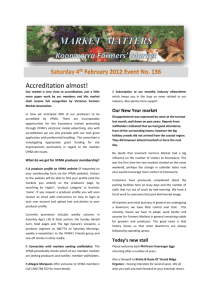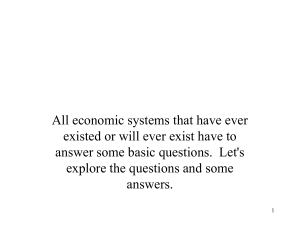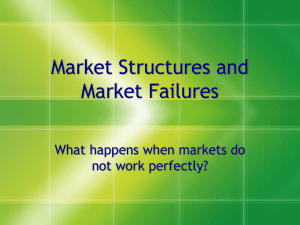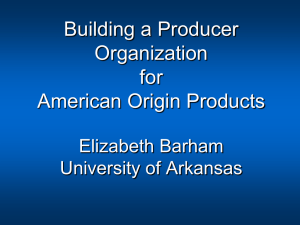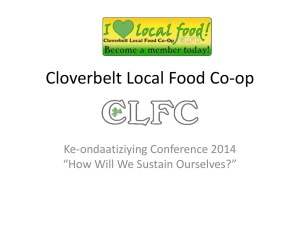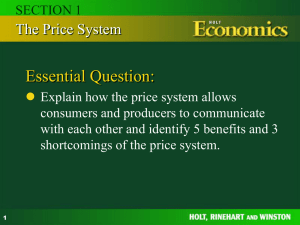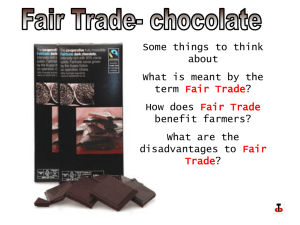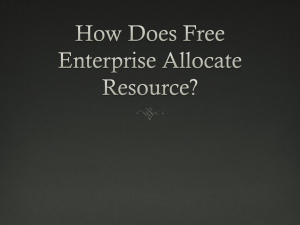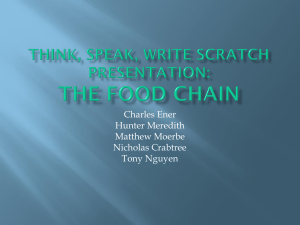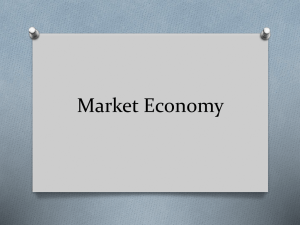Study questions
advertisement
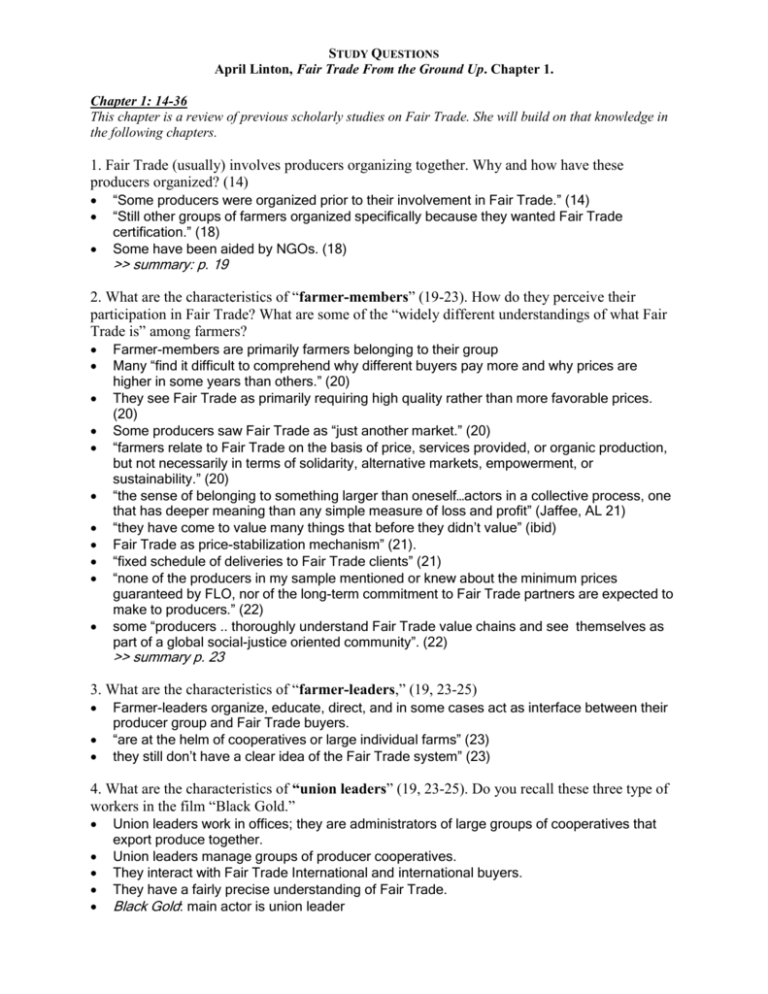
STUDY QUESTIONS
April Linton, Fair Trade From the Ground Up. Chapter 1.
Chapter 1: 14-36
This chapter is a review of previous scholarly studies on Fair Trade. She will build on that knowledge in
the following chapters.
1. Fair Trade (usually) involves producers organizing together. Why and how have these
producers organized? (14)
“Some producers were organized prior to their involvement in Fair Trade.” (14)
“Still other groups of farmers organized specifically because they wanted Fair Trade
certification.” (18)
Some have been aided by NGOs. (18)
>> summary: p. 19
2. What are the characteristics of “farmer-members” (19-23). How do they perceive their
participation in Fair Trade? What are some of the “widely different understandings of what Fair
Trade is” among farmers?
Farmer-members are primarily farmers belonging to their group
Many “find it difficult to comprehend why different buyers pay more and why prices are
higher in some years than others.” (20)
They see Fair Trade as primarily requiring high quality rather than more favorable prices.
(20)
Some producers saw Fair Trade as “just another market.” (20)
“farmers relate to Fair Trade on the basis of price, services provided, or organic production,
but not necessarily in terms of solidarity, alternative markets, empowerment, or
sustainability.” (20)
“the sense of belonging to something larger than oneself…actors in a collective process, one
that has deeper meaning than any simple measure of loss and profit” (Jaffee, AL 21)
“they have come to value many things that before they didn’t value” (ibid)
Fair Trade as price-stabilization mechanism” (21).
“fixed schedule of deliveries to Fair Trade clients” (21)
“none of the producers in my sample mentioned or knew about the minimum prices
guaranteed by FLO, nor of the long-term commitment to Fair Trade partners are expected to
make to producers.” (22)
some “producers .. thoroughly understand Fair Trade value chains and see themselves as
part of a global social-justice oriented community”. (22)
>> summary p. 23
3. What are the characteristics of “farmer-leaders,” (19, 23-25)
Farmer-leaders organize, educate, direct, and in some cases act as interface between their
producer group and Fair Trade buyers.
“are at the helm of cooperatives or large individual farms” (23)
they still don’t have a clear idea of the Fair Trade system” (23)
4. What are the characteristics of “union leaders” (19, 23-25). Do you recall these three type of
workers in the film “Black Gold.”
Union leaders work in offices; they are administrators of large groups of cooperatives that
export produce together.
Union leaders manage groups of producer cooperatives.
They interact with Fair Trade International and international buyers.
They have a fairly precise understanding of Fair Trade.
Black Gold: main actor is union leader
5. What are some of the benefits that producers see with Fair Trade? (24)
strengthen organizations and permits learning about how the market function in a less
competitive atmosphere
Better prices
Technical assistance
Credit
Solidarity and social justice
cultural preservation
increased democracy
women’s empowerment
community development.
way to be heard by government
6. Fair Trade is not easy for the producers. What are some of the challenges producers face?
achieving certification is a formidable process, involving inspections, additional record
keeping, and fees (25)
certification fees (25)
some still face food insecurity (25-26)
7. Fair Trade does not always work the way it is supposed to. What are some of the ways Fair
Trade can fall short in some contexts?
yet certification does not guarantee that a producer group will sell all (or any) of its produce
under Fair Trade terms. Low Fair Trade sales may be due to a group’s newness to Fair
Trade markets or to inadequate quality. (25)
some of the money goes to service debts or pay administrators salaries (26)
money not paid directly to the producer but to the cooperative (26): Jaffee argues for direct
payment to farmers rather than their cooperatives or unions.
With plantations, plantation owners may benefit but not the workers, who are still paid
minimum wage. (26)
“In Darjeeling, Fair Trade standards … have undermined what local laws and government
labor officers have done to promote social justice” (Sarah Besky) (26)
Some buyers don’t pay the social premium, and then market their tea as “tea from a Fair
Trade plantation” as opposed to “Fair Trade tea” (26)
Sometimes women are not empowered (27) {but sometimes they are}
8. How does Linton see the creation of Fair Trade guidelines? What happened in South Africa
that she sees as a positive development? (35-36)
“Drafting and revising Fair Trade guidelines is a process, not a circumscribed task.”
In South Africa there was a “reconstruction of fairness. Fair Trade International shifted a
forum from Europe to South Africa. This lead to Fair Trade “conventions more sensitive to
the interests of South African workers,” and “a process that entrenched a more robust
‘empowerment’ agenda.”
Chapter 3: How Do Producers Spend Their Social Premium? 55-58, 72-75
1. In what ways is the “social premium” used to build a stronger sense of community? In what way does it
support sustainability, and what kind of sustainability? In what ways does it empower communities?
“The majority of the Fair Trade producer groups are contributing to the well-being of their
communities and regions by building or supporting schools, wells, roads, and health care
facilities.” (72)
“Fair Trade is benefitting entire communities in the global South.” (75)
“cooperatives nurture a sense of solidarity just as they train producers and advocate an
entrepreneurial spirit.” (75)
“Fair Trade has given small-scale producers the economic security to enable them to
develop and take charge of their own lives within the cooperative network.” (Pirotte et al,
quoted 75)
“relative economic security is contributing to Fair Trade producers’ solidarity.” (75)
there is a link between “increased capacity building in the economic and social realms”
and “empowerment in the political realm.” (75)
2. What are the main conclusions the authors reached from their research (there are lots!)?
“The majority of the Fair Trade producer groups are contributing to the well-being of their
communities and regions by building or supporting schools, wells, roads, and health care
facilities.” (72)
“Younger producer groups and those in more-developed countries are less likely to
spend any of their Fair Trade premiums on public goods.” (72)
“Fair Trade producer groups that allocate fund towards general education tend to be in
countries with relatively low HDI scores, have more experience with Fair Trade, and also
spend on community health and infrastructure.” (72)
“Fair Trade producer groups are establishing and prioritizing local development goals,
especially in the least-developed countries….” (72)
“size was not an important predictor of a Fair Trade producer group’s contributions to
public goods.” (73)
“Market access and annual production do not matter in terms of the general decision to
spend premiums on public goods, and annual production is significantly related only to
spending on public health initiatives.” (74)
“Fair Trade is benefitting entire communities in the global South.” (75)
Chapter 4: Selling and Buying Fair Trade
1. What does Linton mean by “social value” and how does Fair Trade “sell” that?
“what they are really selling is a social value: putting your money behind Fair Trade will
help alleviate severe social inequalities faced by farmers in less-developed countries.”
(76)
2. What is “cause-related marketing” and “brand extension”? (78)
BRAND-EXTENSION
“For businesses that already enjoy strong brand loyalty from their customers, the Fair
Trade label could become a ‘brand extension.” (78)
“the company’s interest is in branding its own program, not simply promoting the
certifiers they work with.” (78)
CAUSE-RELATED MARKETING
marketing strategy of linking the business with relevant social issues. (Linton 78)
“businesses can therefore promote brand attachment by using Fair Trade to add to their
brand’s “soul”. (Linton 78)
3. What kind of criticisms have been made by brand extension marketing? What kind of responses have
been made against these criticisms? (79)
“it makes retailers’ sourcing look more ethical than it really is….”
“at least potentially—pits various ethical labeling initiatives against each other.”
“Another point of contention is that Fair Trade USA requires less of a commitment to Fair
Trade as a proportion of total sales volume (of coffee, for example) from large retailers
than it does from smaller companies.”
Fair Trade USA justifies this decision by reasoning that (1) a smaller percentage is still a
very large volume, which means more money for the producers and (2) the big
companies need to ‘test the water’ to assess their customers’ demand for Fair Trade. If
the demand is there, Fair Trade purchases will increase”
4. Bezencon and Blil distinguish between five types of strategies and practices related to selling Fair
Trade products. What are the five? What are the terms they come up with to describe them, and do they
seem appropriate and informative? (82-83)
1. Defensive CSR (Corporate Social Responsibility) business. “Contrast” with usual
practices. McDonalds Switzerland.
2.
3.
4.
5.
Proactive CSR business. Goal of “diversification” of firm’s offerings. Coop.
Proactive CSR business. Motivated by “individual ideology.” La Semeuse.
Value-driven business. In line with established “corporate culture.” Switcher.
Fair Trade organization. “Devotion” to promoting equitable commerce. Magasin du
Monde.
5. What significance and impact do you think these distinctions would have with you and with other
consumers? Would you or others choose to buy from one company rather than another depending on
their approach to Fair Trade? (83)
6. How do some criticize mainstreaming, recruiting the large retailers’ participation in Fair Trade? How
does Linton view this issue? (83-84)
“McFair,” “blue-washing”: Large retailers buy relatively small amounts but enhancing
their image by association with Fair Trade
“their work does not support the claim that mainstreaming is weakening the Fair Trade
movement; rather, it is exposing a whole different set of customers to Fair Trade
products while increasing revenues to farmers.” (84)

